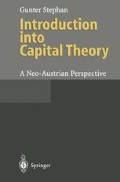Abstract
In a traditional, finite horizon equilibrium framework with a finite number of consumers and producers, the first theorem of welfare is valid, hence a competitive equilibrium is always Pareto-efficient. Profit maximization of firms and utility optimization by consumers result in an allocation where no individual can be made better off without making any other worse.
Access this chapter
Tax calculation will be finalised at checkout
Purchases are for personal use only
Preview
Unable to display preview. Download preview PDF.
References
See Chapter 7. To summarize the most important arguments, let us repeat: To establish the existence of a competitive equilibrium it is essential to assure the existence of a competitive price system. In finite horizon economies this can be done by applying a separating hyperplane theorem (see Chapter 4). It is well-known, however, since the contributions of MALINVAUD (1953, 1962), RADNER (1967), and especially BEWLEY (1973), that a hyperplane separation theorem is a less powerful tool in infinite dimensional spaces. Consequently, infinite horizon price systems fail to exist without additional assumptions. For a general discussion of the price problem in infinite horizon economies see Chapter 8 or STEPHAN (1985, 1986). For the relationship between the price and equilibrium problem see WELCH (1979).
Here, I do not want to use the expression “myopically”, since it is supposed that households maximize life-time utilities, whereas myopia usually implies, households have a planning horizon shorter than their life-time.
This explains, why the unboundedness of the time horizon alone is not the full explanation of the Pareto-paradox, observed in an overlapping generations structure. It is the double infinity, but finite life-time character of the model. If for example there is a finite number of infinitely living agents, then it is reasonable to suppose that all agents can meet on a complete set of forward markets at the beginning of the time horizon. And indeed, in this case the failure of the first theorem of welfare is not observed (see HOMBURG 1992).
For an exact definition, see Section 9.5.
Author information
Authors and Affiliations
Rights and permissions
Copyright information
© 1995 Springer-Verlag Berlin Heidelberg
About this chapter
Cite this chapter
Stephan, G. (1995). Overlapping Generations, Superiority of Roundaboutness and Pareto-Efficiency. In: Introduction into Capital Theory. Springer, Berlin, Heidelberg. https://doi.org/10.1007/978-3-662-03081-3_9
Download citation
DOI: https://doi.org/10.1007/978-3-662-03081-3_9
Publisher Name: Springer, Berlin, Heidelberg
Print ISBN: 978-3-642-08216-0
Online ISBN: 978-3-662-03081-3
eBook Packages: Springer Book Archive

